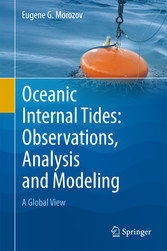Search and Find
Service
Oceanic Internal Tides: Observations, Analysis and Modeling - A Global View
This book presents a detailed study of the structure and variability of internal tides and their geographical distribution in the ocean. Based on experimental analysis of oceanic measurements combined with numerical modeling, it offers a comprehensive overview of the internal wave processes around the globe. In particular, it is based on moored buoys observations in many regions in all oceans (Atlantic, Pacific, Indian, Arctic, and Southern) that have been carried out by researchers from different countries for more than 40 years as part of various oceanographic programs, including WOCE and CLIVAR. However, a significant portion of the data was collected by the author, who is a field oceanographer. The data was processed and interpreted on the basis of the latest knowledge of internal wave motion. The properties of internal waves were analyzed in relation to the bottom topography and mean state of the ocean in specific regions.
Internal waves play a major role in the formation of seawater stratification and are responsible for the main processes of ocean dynamics, such as energy transfer and mixing. One of the most significant ideas presented in this book is the generation of internal tides over submarine ridges. Energy fluxes from submarine ridges related to tidal internal waves greatly exceed the fluxes from continental slopes. Submarine ridges form an obstacle to the propagation of tidal currents, which can cause the creation of large amplitude internal tides. Energy fluxes from submarine ridges account for approximately one fourth of the total energy dissipation of the barotropic tides. Model simulations and moored measurements have been combined to generate a map of global distribution of internal tide amplitudes.
This book is of interest to oceanographers, marine biologists, civil engineers, and scientists working in climate research, fluid mechanics, acoustics, and underwater navigation.
Eugene Morozov is Head of the Laboratory of Hydrological Processes at the Shirshov Institute of Oceanology in Moscow (Russia). He has been working at this Institute since graduating from the Moscow Institute of Physics and Technology in 1970. His research focuses on oceanic internal waves and large-scale circulation of the ocean. He is a field oceanographer and a specialist in observations in the open ocean. He works on data acquisition, data processing, interpretations, and partly numerical modeling. His interests are in the interaction of the ocean water and glaciers descending to the fjords, and since 2002 he has been investigating the abyssal flows in the Atlantic Ocean and abyssal circulation, especially in the flows in the deep fractures, and since 2008, he has been also working on the problems of Arctic oceanography in cooperation with scientists from the University Centre in Svalbard. During his oceanographic career Dr Morozov has participated in 44 long expeditions in all oceans of the globe and in 15 coastal expeditions. His field work is related to internal tides and currents in the ocean, such as the Gulf Stream, Kuroshio Current and its rings, Antarctic Circumpolar Current, Falkland Current, California Current, and equatorial countercurrents in the Indian and Atlantic oceans. He was a guest scientist at Woods Hole Oceanographic Institution (USA), Netherlands Institute for Sea Research, Universidad Complutense de Madrid (Spain), University Center in Svalbard, Universidad de Buenos Aires, Universidad de Montevideo, Arizona State University (USA), Florida State University (USA), the University of Victoria (Canada), and the University of Cape Town. In 1999 he became a member of the Executive Committee of the International Association for the Physical Sciences of the Ocean (IAPSO), and from 2011 to 2015 he was the President of this association. He was also a member of the Executive Committee of the International Union of Geodesy and Geophysics (IUGG) and a member of the Executive Committee of the Scientific Council on Oceanic Research (SCOR).
All prices incl. VAT












